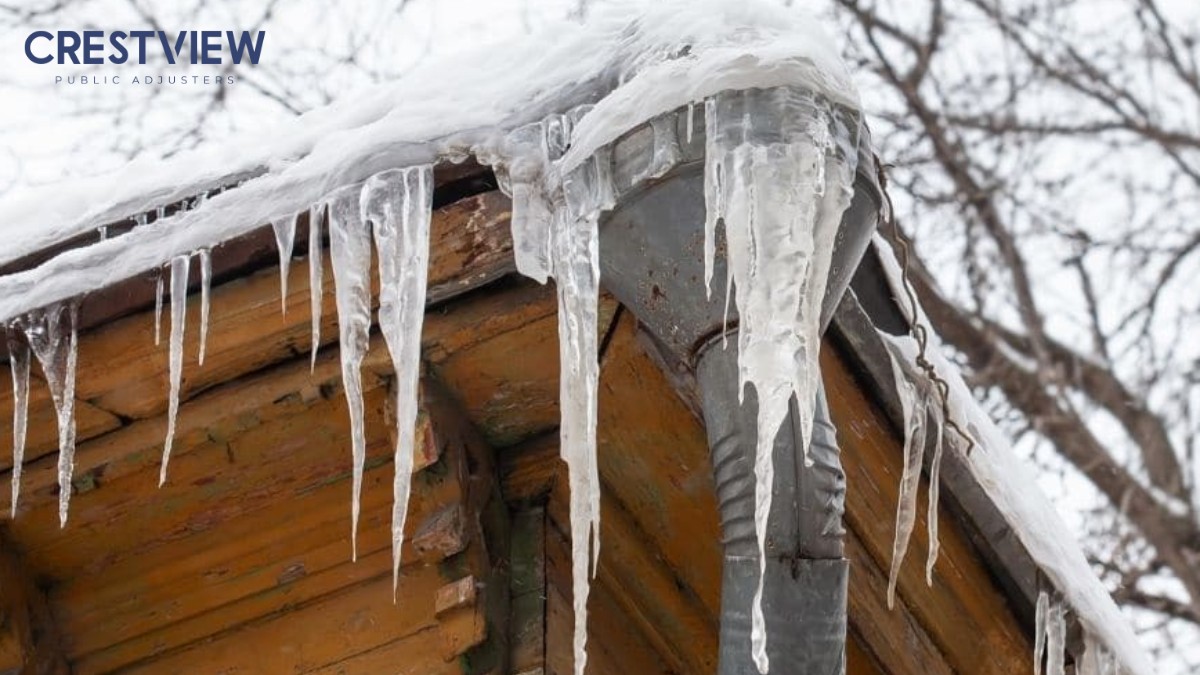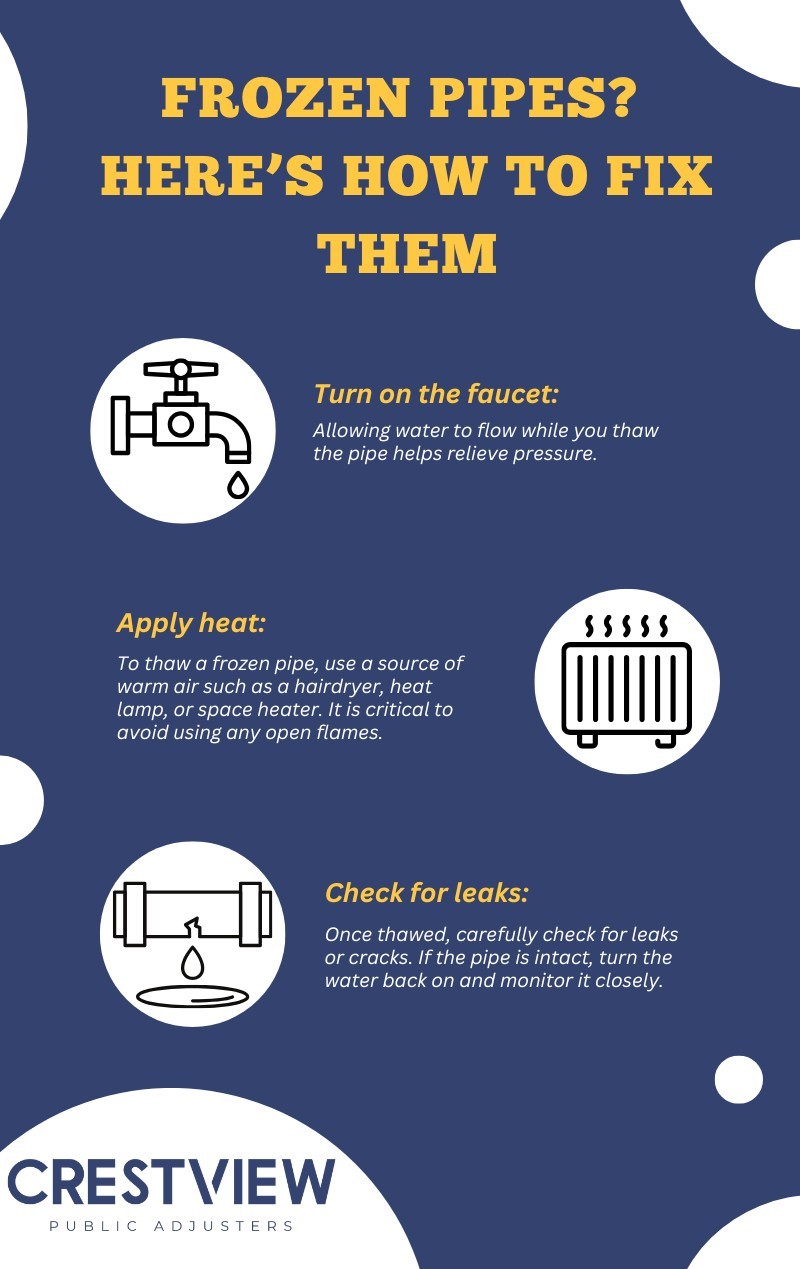Key Points:
- Frozen pipes and burst pipes are distinct problems with different causes and consequences.
- Understanding the differences between the two can help in preventing damage and addressing repairs more effectively.
- If you experience issues related to frozen pipes or burst pipes, consider seeking help from public adjusters to navigate insurance claims in New York, New Jersey, and Florida.
Winter can be tough on your plumbing. These incidents can result in costly repairs and significant damage. As temperatures drop, you may hear terms like “frozen pipes” and “burst pipes” being thrown around. However, these two are often confused, and while they’re related, understanding the differences can make a world of difference in managing these common wintertime threats.
In this article, we’ll explore the core differences between frozen and burst pipes, the causes behind these issues, the signs to look out for, and how they impact your home. Additionally, we’ll cover what steps you should take to prevent these problems and what you can do if you experience damage from either issue. By the end of this guide, you’ll be better equipped to handle these plumbing disasters, should they arise.
What is a Frozen Pipe?
Frozen pipes are exactly what they sound like: pipes that have frozen due to low temperatures. When the temperature drops significantly, water inside the pipe can freeze, creating blockages and potentially putting pressure on the pipe walls. This pressure increases as the water expands when it freezes, leading to the possibility of a burst pipe.
While a frozen pipe doesn’t always result in a burst, it’s one of the most common causes of plumbing issues during the winter months. Frozen pipes are often found in areas of your home that are less insulated, such as basements, attics, or exterior walls. These areas are more susceptible to extreme cold, making them prime locations for pipe freezing.
Signs of a Frozen Pipe:
- No water flow – If you turn on the tap and no water comes out, it’s a clear sign that a pipe may be frozen.
- Frost on the pipe – If you notice any frost buildup on your pipes, they’re likely frozen.
- Strange odors – A frozen pipe can prevent water from flowing, which may cause stagnation, leading to unusual smells.
It’s crucial to recognize these early warning signs to avoid further complications like a burst pipe, which could be a costly problem. The good news is that frozen pipes can usually be thawed without much damage if addressed quickly.
What is a Burst Pipe?
A burst pipe occurs when a frozen pipe finally gives in to the pressure built up from the ice. As the water inside the pipe expands, the pipe walls weaken, leading to cracks or ruptures. A burst pipe is a more severe problem than a frozen one because it allows water to flow freely, often causing extensive damage to walls, ceilings, and floors.
If you’ve had a frozen pipe that wasn’t dealt with in time, chances are it could burst. Burst pipes can happen anywhere in the plumbing system, but they’re more likely in areas where freezing is common or where pipes are already old and weak.

Signs of a Burst Pipe:
- Water pooling – Large amounts of water or flooding in areas where pipes run is a strong indication of a burst pipe.
- Water pressure loss – A sudden drop in water pressure throughout the house often signals a burst pipe somewhere in the system.
- Visible cracks or leaks – You may notice visible cracks, damp spots, or wet areas on walls or ceilings near where the pipes are located.
While frozen pipes are a precursor to burst pipes, the aftermath of a burst pipe is much more damaging. Immediate action is necessary to mitigate the damage and prevent long-term issues like mold growth or structural deterioration.
How Do Frozen Pipes Lead to Burst Pipes?
Frozen pipes and burst pipes are intimately connected in that frozen pipes create a high risk of bursting. The process begins when the temperature dips so low that the water inside the pipe freezes. As the water freezes, it expands, creating pressure inside the pipe. Once the pressure exceeds the pipe’s ability to withstand it, the pipe will rupture.
A burst pipe can happen in an instant, but it often occurs after a long period of pressure buildup. The longer the pipe remains frozen without thawing, the more pressure builds up, making the pipe more likely to burst. This process may happen with no warning, leaving homeowners with a mess that needs immediate attention.
How to Prevent Frozen Pipes:
- Insulate exposed pipes – To safeguard pipes in areas lacking insulation, employ either foam insulation tubing or heat-conductive tape.
- Maintain consistent temperatures – Keep your home at a consistent temperature, even when you’re not around.
- Let water drip – If temperatures are extremely low, leaving faucets slightly open allows water to move, reducing the chance of freezing.
Proper insulation and taking preventative measures before the cold sets in can significantly lower the chances of your pipes freezing and bursting.
How to Thaw Frozen Pipes and Fix a Burst Pipe
If you discover a frozen pipe, acting quickly can help prevent a burst pipe. Here’s how to thaw a frozen pipe safely:

If a pipe has ruptured, it is critical to immediately turn off the main water valve to prevent further flooding. Afterward, you should call a plumber to assess and repair the damage.
Why Is It Important to Differentiate Between Frozen Pipes and Burst Pipes?
Understanding the difference between frozen and burst pipes is crucial for proper damage control. If you address a frozen pipe early, you may prevent it from becoming a burst pipe and causing significant damage. However, if the pipe has already burst, it requires a much more immediate response to avoid further issues. Recognizing the warning signs can help minimize the damage and speed up the repair process.
Key Differences:
- Frozen pipes are caused by cold temperatures, whereas burst pipes are the result of extreme pressure within frozen pipes.
- Frozen pipes often don’t cause immediate damage, but burst pipes can cause significant flooding and damage to your home.
- Preventing frozen pipes is easier, as it involves proper insulation and taking preventive steps, while burst pipes require quick response and professional repairs.
Don’t Wait! Act Fast if You’re Dealing with Frozen or Burst Pipes
If you’re dealing with a frozen pipe or burst pipe in Florida, New York, or New Jersey it’s crucial to act fast and prevent further damage to your property. If you’re unsure about your next steps or need help filing an insurance claim, public adjusters like Crestview can guide you through the process. Their expertise ensures that you receive the compensation you deserve for damages caused by frozen or burst pipes. Contact Crestview to handle your frozen pipe claims efficiently and ensure a smooth, fair resolution.

